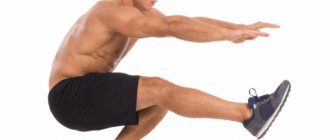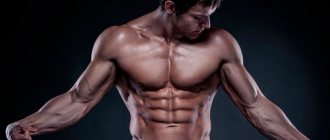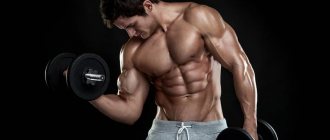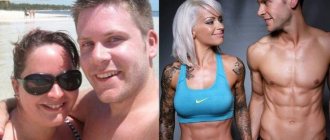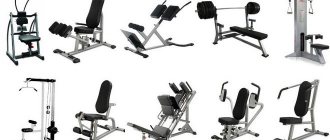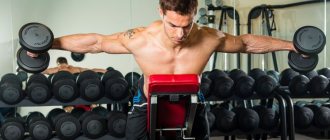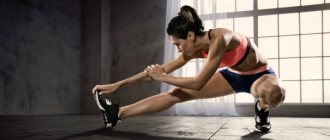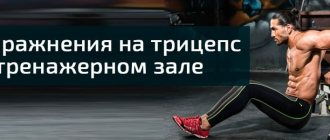The training program in the gym for beginners will be the same both for gaining weight and if you need to “remove your belly.” Unless for fat burning you will need to add cardio (running, elliptical trainer, etc.) The first workouts in the gym for men are learning basic strength exercises with a barbell and dumbbells (squats, deadlifts, barbell presses, etc.) . And to lose weight or vice versa, to grow muscle mass, you need to change your diet (recommendations at the end of the article).
Training program for drying the body
Split training program for men (mass)
Nutrition program for gaining muscle mass
How can I “create an individual training program”? It turns out that the same training program is suitable for all beginners? Yes! Everyone in the gym is first given the same training plan, the same basic exercises. And this is correct, because there are no magical exercises that will only make you lose weight or only build muscles. For beginners, the result depends almost entirely on nutrition. Plus, those who want to lose weight faster need to add cardio.
We emphasize that all this applies specifically to beginners, and for “continuing” programs for cutting and gaining muscles will be different.
How often and for how long to train?
The training program in the gym for men is designed for three times a week. The duration of one workout is 1.5 hours (including warm-up). Don't slack off, don't chat on the phone or with other jocks between exercises. The maximum rest between exercises is 60-90 seconds. But you don’t need to train half to death for 2 hours each time. 15-30 minutes warm-up and cool-down, 40-60 minutes – the main part of the workout. Excessive zeal is as bad as laziness.
The break between training is 1-2 days. If you need to lose weight, then cardio can be done either after training, or on a separate day, whichever is more convenient. You don’t have to do it, but you’ll lose weight faster with cardio.
How can a beginner organize classes without a coach?
Experienced athletes can easily create a suitable training program. Beginners can also do this task if they follow the following rules:
- Preparation of a training plan. At the beginning of any lesson there should be a warm-up (about 15 minutes), 2 ligaments for the main muscle group (for example, legs, back), 2-3 exercises for secondary muscles (for example, biceps, triceps) and a cool-down (5-10 minutes) . If you are focusing on weight loss, you need to leave at least 20 minutes for cardio after standard strength training.
- Setting the frequency. Weakened muscle groups can be trained twice a week with an even break to ensure proper rest for the body.
- Selection of suitable exercises. To begin with, you should choose basic loads or options on simulators. Isolation exercises are added gradually and last to control lagging muscles. The specific list of exercises depends on the availability of specific exercise machines and special equipment in the selected gym.
- Determining the number of approaches. The basic number of individual sets for large muscle groups should be 12-15 (3-4 exercises, 3-4 sets). For the first set, a fairly heavy weight and reduced number of repetitions should be used, and subsequent repetitions should be gradually increased.
Abdominal exercises should be added regardless of the training day, since this area recovers quite quickly.
Gym training program for men (for beginners)
Training for beginners means working out all muscle groups in each workout. Often, trainers suggest doing a split workout right away (one workout – one muscle group), but we recommend doing exercises for the whole body (or 2 muscle groups) every time at first.
Click on the name of the exercise or on the picture and see a detailed description of the exercises.
- Monday
- Wednesday
- Friday
1 Pull-ups*
Maximum number of repetitions * 3 sets
*if you can’t do pull-ups yet, use a gravitron or ask a trainer/partner to push you with their hands. You can also put a chair below and do negative pull-ups (quickly push your feet up from the chair and slowly lower it)
2 Barbell deadlift
10-12 reps * 3 sets
3 Leg press
12-15 reps * 3 sets
4 Seated dumbbell press
12-15 reps * 3 sets
5 Ab crunches (“prayer”)
15-20 reps * 3 sets
1 Bench press
10-12 reps * 3 sets
2 Dumbbell lateral raises
12-15 reps * 3 sets
3 Romanian Deadlift (straight legged)
10-12 reps * 3 sets
4 Leg extensions on the machine
12-15 reps * 3 sets
5 Pull-down to chest
12-15 reps * 3 sets
6 Triceps extensions
12-15 reps * 3 sets
1 Hyperextension*
During the first workout - without additional weights.
Next, pick up a weight plate or a dumbbell (at first 5 kg, as it becomes easier - 7 kg, etc.). But don’t rush to immediately take a heavier pancake! You should not have back pain when you do hyperextension. 12-15 reps * 3 sets
2 Squats with a barbell
10-12 reps * 3 sets
3 Lunges with dumbbells
You can do 8 repetitions with one leg first, and then 8 with the other. Or you can do 16 repetitions alternately
16 times (8 with each leg) * 3 sets
4 Block pull behind the head
12-15 reps * 3 sets
5 One-arm dumbbell row
20 times (10 with each hand) * 3 sets
3 Raising legs with emphasis on elbows
12-15 reps * 3 sets
How to exercise without a trainer
To begin with, a beginner should decide on problem areas - focus on working out individual muscle groups. This will create the basis and guiding goal of the training. Each lesson should begin with a quality warm-up - cardio, joint gymnastics.
You should always start with a warm-up. To do this, spend 5 minutes doing cardio (brisk walking, treadmill, elliptical or exercise bike), stretch your joints and stretch. If you ignore warming up, you risk damaging your muscles and injuring yourself.
Next, start working on individual zones:
- back and trapezius. Pumped up using deadlifts (light weights). You can first prepare the extensor muscles with the hyperesthesia exercise, pulling the lower block to the abs or the upper block to the chest;
- legs. You should perform bench presses, squats with weights, lunges using a barbell and dumbbells;
- breast. For this zone, barbell presses in a lying position and dips on uneven bars will be effective.
Even experienced athletes periodically need advice and help from a qualified coach. Therefore, beginners should at least take a trial lesson to familiarize themselves with the correct technique for performing individual exercises and the rules of working with exercise equipment.
Nutrition: diet and sports nutrition for men
For fat burning (“for relief”)
To “get rid of belly fat” and in general to lose weight, you need to “eat less.” It's actually quite simple - less calories, more training and any physical activity. Repeat until results are achieved. If you simply train according to the best training program for men, but eat haphazardly, then even if you lose weight, it will not be much and not for long. Therefore, learn to count calories.
You can try fat burners from sports nutrition when you have very little energy and need to train. Fat burners and pre-workouts by themselves do not burn fat; they will only help if you exercise. Protein, gainers, etc. - no need.
For muscle gain (“for mass”)
If you are thin and want to pump up, then you also need to count calories. Only there should be more of them than you spend in a day. Calculate your daily intake and add 500 kcal. This is how much you need every day for muscle growth.
You can take protein, gainers, amino acids, and creatine from sports nutrition. It’s convenient to take protein to work/school and drink it immediately after training. But if you eat well (regularly, enough calories and nutritional supplements), then sports nutrition is not needed.
Nutrition for gaining muscle mass: Calories and nutritional supplements
Choosing Whey Protein – Which is Best?
Strength training with dumbbells at home (Day 1)
It is known that it is better to start training with the most difficult exercises, being at the maximum of your strength. We recommend starting the first day with squats and push-ups, which involve almost all muscle groups of the body. Finally, do one of the ab workout variations to strengthen your core and abs.
Important! Do not neglect the warm-up approach; first do each exercise with minimal weight. This technique will help you move more confidently and technically with heavier dumbbells.
For a pre-workout warm-up, check out:
- Universal warm-up for 3-5 minutes
- 30 exercises to warm up before training
- Ready-made warm-up and stretching for arm and shoulder training
Squats with dumbbells
Working muscles: biceps, quadriceps and hip adductors, gluteus medius and maximus, abs, forearms, biceps.
How to do it:
Take a dumbbell in each hand and stand straight with your feet shoulder-width apart. Bend your elbows, placing dumbbells on your shoulders. Lower yourself into a squat, arching your lower back slightly so as not to arch your back. Make sure that your knees are in line with your toes; to do this, do not squat too low - your thighs should be parallel to the floor.
If it is difficult to maintain balance, then place your feet a little wider. Fix your arms in one position, this will also help you maintain balance and concentrate on squats - the best strength exercise for legs at home that you can do regularly.
Push ups
Working muscles: pectoralis major, deltoids, triceps, serratus anterior, abs, core.
How to do it:
Stand in a lying position with your palms under your shoulder joints, your eyes looking forward, your body extended in one line. Bend your elbows, lowering your chest as low as possible. Don't sag in your back or lift your pelvis high. When your shoulders become parallel to the floor, you can rise up.
The work of different muscle groups depends on the positioning of the hands during push-ups: with a wide one, the pectorals work, with a narrow one, the triceps. If you use an elevation for one or both arms, the rhomboid muscles of the back and trapezius will be involved in the work.
Bent-over dumbbell rows
Muscles worked: latissimus dorsi and rhomboids, rear deltoids, shoulder muscles.
How to do it:
Lean forward with your back straight, knees slightly bent. Hold dumbbells in both hands with a neutral grip. Keep your back exactly in line with your neck and head. Pull the dumbbells up to the line of the body, while working the back muscles, not the arms. You can lift dumbbells on both hands at once or alternately if you have a lot of weight.
When performing the exercise, do not change the position of the body, it must be motionless, in this case the target back muscles will work. Do this great strength exercise at home and you will soon have a wide and strong back.
Dumbbell Curl with Supination
Working muscles: biceps, brachialis, forearms.
How to do it:
Take dumbbells in your hands; in the initial position, the shells should be parallel to the body. Bend your elbows and, as you lift the dumbbells up, turn your hands inward, toward your body.
Full body strength training has a place for pumping up the biceps. Lifting dumbbells for biceps with supination (rotation of the hand) is considered more effective than usual, since in this case the small muscles of the forearms are involved in the work and the wrists and hands are additionally strengthened.
Lateral Dumbbell Raises
Working muscles: lateral (middle) deltoids, muscles of the forearms.
How to do it:
Take dumbbells in your hands and stand straight, preferably in front of a mirror. Lower your arms down and bend your elbows at a slight angle. Begin to spread your arms to the sides, with your elbows turned back. Raise both arms synchronously until they are parallel to the floor, and after a couple of seconds, lower them to the starting position. Do not straighten your arms; they should be slightly bent at the elbows.
Incorrect technique leads to other emphasis during training, for example, trapezius is involved, which reduces the load on the target muscles. Perform proper, effective strength exercises at home to build up your shoulders.
Dumbbell extension from behind the head
Muscles worked: triceps, anconeus.
How to do it:
Take a dumbbell and sit on a bench. The back is straight, the legs are stable. Hold the projectile vertically with both hands, palms up. Raise the dumbbell with straight arms above your head and begin to slowly bend your elbows, lowering the dumbbell down behind the back of your head. You can perform this exercise while standing, but in a sitting position, the triceps will receive a more accentuated load.
When bending and extending your arms, it is important not to make sudden movements, so as not to dislocate the shoulder joint or hit yourself with a dumbbell. It is also important not to spread your elbows out to the sides, which reduces the effectiveness of the exercise. Perform this simple strength exercise at home to “strengthen” your triceps, because they are responsible for the volume in the upper arms.
When will there be results from training?
If you have a lot of excess fat, then in a month a man can lose 5-10 kg. Most of the weight will go away with water and intestinal contents, but nevertheless, you will notice progress in your clothes - they will become a little large. If you just need to “remove your belly” a little, you will lose less weight (5 kg), but it will also be noticeable. The general rule is that the more excess weight you have, the faster it goes away at first. From the second month you will slow down and each kg will be lost in a week or two.
If you want to pump yourself up, then the results will not be so noticeable. No matter what fitness models promise when they advertise their 30-day super course, you won’t be able to get pumped up quickly. Especially if there is no sports training at all. Very thin guys need to train in the gym for at least a year to see noticeable results. And to get to the “pumped up guy” you need to work for 5 years. Such deadlines are terribly demotivating. And smiling trainers with wide backs tempt you to try steroids. But we recommend that you first thoroughly study all the side effects, watch a video like this (average age 30-40 years, the main problem is the heart). And under no circumstances should you take steroids if you’ve been training for less than a year (or better yet, forget about them completely).
The right gym training program for men is one in which you exercise regularly, do the exercises correctly and (very important for beginners) - do not try to set records in the first month of training. If you lay a good foundation, you will have less risk of injury in the future and will ultimately get results faster. Therefore, we recommend that you consult with a trainer and get ready for a long work. Truly impressive results in any business are always the result of long work. And free cheese is always in the mousetrap.
If you liked the article, share with your friends!
.
Exercise plan for those starting after 40 years old
Natural recovery processes in the body slow down significantly after 40 years. The main reason is a decrease in the production of the male sex hormone testosterone. To start sports activities, men of this age will need 2 times a week to fully exercise their muscles. After gradual adaptation of the body, you can increase the number of strength training up to 3-4 times.
Sample lesson plan:
Day 1
- Warm-up – 15 minutes.
- Smith squat – 3 sets of 8-10 reps.
- Leg extensions in the simulator - 3 sets of 12 times.
- Bench presses – 3 sets of 10-12 reps.
- Chest rows – 3 sets of 10 reps.
- Dumbbell presses – 3 sets of 12 repetitions.
- Curling arms with weights – 3-4 sets of 10 times.
Day 2
- Warm-up – approximately 15 minutes.
- Kettlebell squats – 3-4 sets of 15 repetitions.
- Dumbbell bench press – 3 sets of 12 reps.
- Raises with weights – 3 sets of 12 reps.
- Push-ups – 3 sets of 10 repetitions.
- Hyperextension – 3 sets of 12 reps.
- Crunches – 4 sets of 10 times.
Note! During exercise, be sure to stay hydrated to prevent dehydration.
Strength training with dumbbells at home (Day 2)
On day two, you'll work your back, legs, shoulders, chest, and even isolate your biceps and calves. Don't forget about the abdominal exercises that are recommended to complete your workout.
Pull-ups
Working muscles: latissimus, rhomboid and teres major muscles of the back, trapezius, muscles of the shoulders and forearms.
How to do it:
This is a great exercise for your back and upper body development. Hang on the horizontal bar with straight arms, tense your core. Do pull-ups by bending your elbows and trying to touch the horizontal bar with your chest. Lower yourself down, straightening your arms completely to give your lats a good stretch.
During pull-ups, do not swing while trying to help yourself with your legs. But if you are a beginner, then jerking movements will help you learn how to do pull-ups. In this case, it is necessary to linger longer at the top point, which will help the muscles adapt to the new load.
If you don’t have a horizontal bar, then perform bent-over dumbbell rows, during which the key back muscles also work.
Bent-over rows (alternative to pull-ups)
Working muscles: latissimus, rhomboids and teres major, trapezius, rear deltoids.
How to do it:
Lean forward with your back straight and your knees bent. Hands with dumbbells are lowered down parallel to the legs. Hold the dumbbells horizontally. Don't lean too far; your chest should be pointing forward. Pull the dumbbells towards your body, bending your elbows. Make sure your elbows bend at right angles. At the top point, squeeze your shoulder blades together so that the entire range of back muscles works.
During this exercise, it is important not to bend at the waist, otherwise you may injure yourself. Maintain a slight arch in your back, which will help prevent injury. In fullbody strength training, special attention is paid to back training, because this is where the largest complex of muscles is concentrated, which affects the appearance of the entire body.
Lunges forward
Working muscles: quadriceps femoris, gluteus medius and maximus, adductor muscles of the thighs, oblique abdominal muscles.
How to do it:
Take the implements in your hands and take a wide step forward, lowering into a lunge. Come back and repeat with the other leg. When performing forward lunges, hold dumbbells with your arms extended downwards. Try not to swing them, otherwise it will interfere with your balance. Don't bend your back, look straight ahead.
Do not bend your knees at an acute angle, otherwise the technique will not only be disrupted, but the load on the knee joints will also increase.
Dumbbell chest raises
Working muscles: pectoralis major, deltoids (front and middle fascicles), biceps, triceps, forearms.
How to do it:
Take the equipment in your hands and lie down on the bench. Raise your arms straight with the dumbbells up, palms facing each other. Bend your elbows slightly and do not straighten them until the end of the approach. Start spreading your arms with dumbbells to the sides, making sure that your elbows are pointing straight down. Lower your arms until you feel a “tightness” in your chest, then raise them up until the dumbbells touch each other.
Strength training for men at home cannot be done without working the chest. This exercise can be performed not only on a straight bench, but also on an inclined bench. Moreover, if the bench is tilted down, you train the lower part of the pecs, and if it is tilted up, then the upper part. On a straight bench, the middle part of the pectoralis major muscles is best used.
If you don’t have a bench or comfortable stools at home, you can perform this exercise on the floor, but in this case the amplitude of the exercise will be less.
Standing Dumbbell Press
Muscles worked: front and middle deltoids, triceps, rhomboids, trapezius.
How to do it:
Stand up straight, dumbbells in straight arms. If possible, stand in front of a mirror to control your technique. Raise your arms straight with dumbbells up. Bend your elbows, lowering the dumbbells to your shoulders, and press them back up. At the lowest point, the dumbbells should be at ear level. When pressing, spread your elbows out to the sides. The axes of both dumbbells should be in the same plane, as if continuing each other.
When performing the exercise, imagine that you are pressing the barbell, as if you were doing a military press. The arms should move in the same amplitude, and the dumbbells should remain motionless and not sway. Perform this effective strength exercise at home to build broad, powerful shoulders.
Bent over arm abduction
Working muscles: triceps, forearms.
How to do it:
Take the dumbbell in your right hand, lean on the bench with your left. Place your left knee on the bench, with your right leg straight. Do not bend at the waist, fix your body in a motionless position. In the initial position, the right arm with a dumbbell is bent at the elbow at a right angle: the forearm is perpendicular to the body, the shoulder is adjacent to the body. Extend your arm with the dumbbell at the elbow, moving it as far back as possible. Repeat for the other side.
This isolated exercise works the triceps, making your arms powerful. If you take a lot of weight, do the exercise slowly, without sudden movements, so as not to injure your elbow joints.
You can do this exercise without a bench:
Lifting on your toes
Working muscles: calf.
How to do it:
Take the apparatus in each hand and stand facing a raised platform (step platform, barbell discs). Place your toes on a hill and keep your heels on the floor. The dumbbells are calmly held in straight, lowered hands. Rise onto your toes, pushing your heels off the floor, and come back.
Strength training for men at home includes exercises to pump up the muscles of the whole body. This exercise will help develop your calves so that your legs look harmonious. In addition to the strength effect, raising your toes helps stretch your muscles, which is good for their elasticity.
Features of strength training
Strength training involves working with heavy weights. High repetitions, blocks and isolation exercises are foreign to athletes whose training is aimed at developing strength. Naturally, such exercises as, for example, lat pull-downs in a machine or leg press in a machine may well be present in the training process, but as an additional load and not even in every workout.
The main features of strength training:
- Training aimed at developing strength mainly consists of compound exercises.
- The main feature of such training is to reduce repetitions. Typically, the exercise is performed up to five repetitions.
- The number of approaches, compared to the usual training to increase muscle mass, is greater. There may be 6-8 of them.
- The rest time between approaches also increases and ranges from three to five minutes. The rest period may last longer.
- Also, to achieve the effect, exercises are used to develop explosive strength. It's a push and pull.
- The amount of training to develop strength will depend on the working weight. For example, if the weight is 100 percent of your one-repetition maximum (1RM), then the workout that includes that exercise should be done once a week. If the weight is lower, for example, 80 percent of the one-rep maximum, then training can be done twice a week.
- Such training should not be carried out more than once every four days.
- Also, you should observe the speed of the exercise. It usually goes from medium to low. This is necessary so that the body does not get used to the load.
But aerobic exercise is completely irrelevant in the training mode to increase strength.
Particular attention should be paid to the technique of performing the exercises. Firstly, due to correct execution, the risk of injury is reduced, and secondly, the correct technique increases the innervation of the muscles (creates a larger number of nerve endings), accordingly, we get a powerful and better muscle response in all the aspects we need.
To develop strength, use the ladder technique , in which the weight increases with each subsequent approach, and the last approaches are performed with maximum weight (either 80% of the maximum or 100%).
To “break through” the stop in strength development that all athletes encounter, presses with a pause along the movement may be relevant. For example, when performing a bench press: the bench press and lowering of the bar are performed with fixation at the center of the amplitude.
Additional exercises can also be added, which were already discussed at the beginning, these are exercises in simulators, and work with dumbbells, and other types of exercises.
